Rhubarb is a perennial plant, which has been grown for centuries around the world. It’s known for being tart and makes a great addition to pies, jams and other desserts. But while rhubarb may look like an ordinary vegetable, it has plenty of unique characteristics that make it stand out from other plants in the garden.
When choosing the best plants for your garden, why not consider those that look like rhubarb? Gardening experts say these types of plants can add texture and color to any space. So, without further ado, here are some of the best garden plants that look like Rhubarb!
Dogbanes
Dogbane plants (Apocynum spp.) are perennials that can reach up to 3 feet in height and produce small, white flowers. They have smooth stems and leaves that resemble rhubarb. Dogbanes thrive in full sun and prefer well-drained soils with a neutral pH. These tough plants are drought tolerant, but will require regular watering during hot, dry spells.
Goatsbeard
This tall perennial plant (Aruncus dioicus) is often mistaken for rhubarb due to its large, lobed leaves and upright stems. Goatsbeard grows best in moist, shaded areas with acidic soil and can reach up to 6 feet tall when mature.
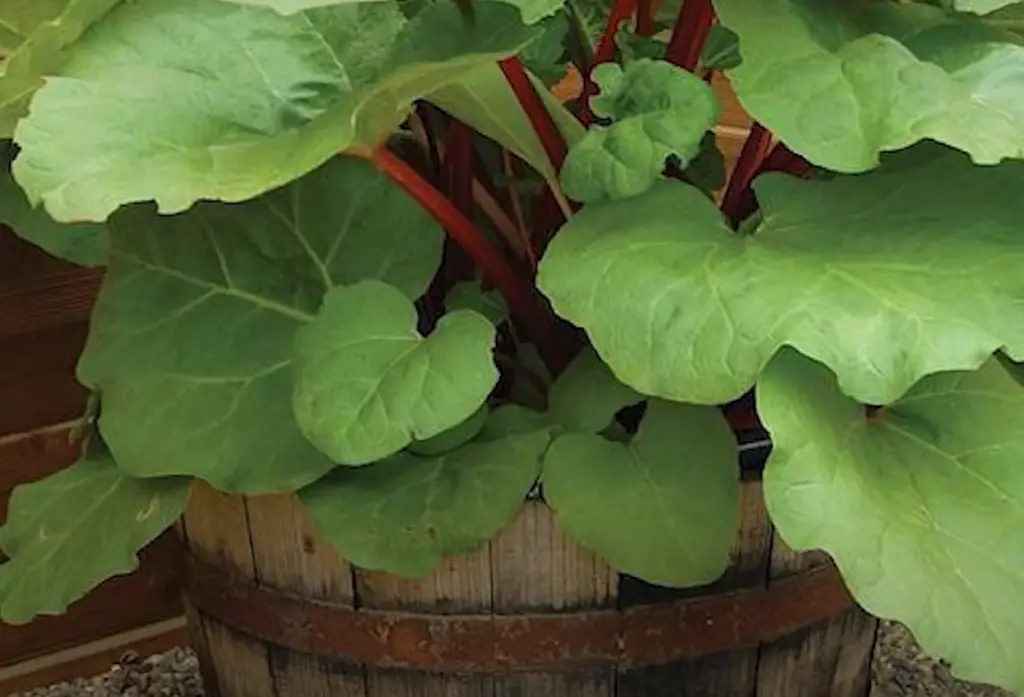
This plant produces white flowers that bloom from late spring to early summer.
Nightshade
Nightshade is an annual plant that comes in two varieties: Solanum carolinense, which grows to three feet tall and has white flowers; and Lycopersicon sclarea, which grows to four feet tall and has purple-violet flowers. Both types of Nightshade have dark green leaves that are slightly fuzzy and look similar to rhubarb. This plant also produces edible fruit, which makes it a great addition to any garden.[1]
Curly Dock
Curly dock (Rumex crispus) is another perennial plant that resembles rhubarb. It grows to two feet tall and has a rosette of wavy, thick leaves with yellow flowers in the summer. This plant is often mistaken for rhubarb because it has similar-looking leaves. It’s also edible, but has a bitter taste that may be unappealing to some.
Buckthorn
Buckthorn is an evergreen shrub that produces a deep red-orange colored fruit. Its leaves are slightly serrated and its stems are thick and dark in color. It’s often mistaken for rhubarb due to the similarities between the two plants, but buckthorn has a more woody texture than rhubarb and its berries are much sweeter. It does well in full sun to partial shade, making it an ideal plant for any garden.
Chilean Rhubarb
Chilean Rhubarb (Gunnera tinctoria) is a large-leafed perennial that grows up to six feet tall. Its leaves appear deep green with reddish veins in the summer and turn purple in the winter months. It also has bright yellow flowers during the summer blooming season.
Plus, its large leaves add an interesting texture and color to the garden landscape.Skunk Cabbage
Skunk cabbage is a hearty plant with large, tulip-shaped leaves and a distinct smell. It’s perfect for adding some fragrance to your garden! Not only does it look like rhubarb, but it also has similar flavor properties as well. Skunk Cabbage will thrive in moist soils and shady areas, making it an ideal choice for those who love to garden in the shade.[1]
Poison Hemlock
Poison Hemlock is a tall, erect plant that looks like rhubarb. It has white flowers and can reach heights of up to six feet. Poison Hemlock is poisonous, so it should be kept away from children and pets.
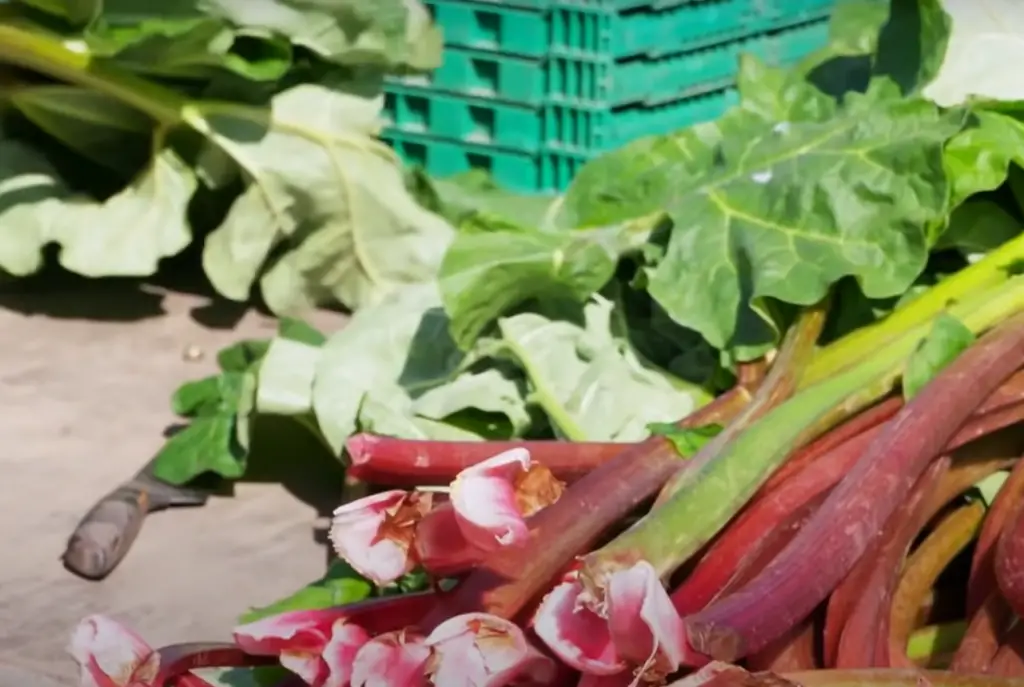
However, it can be used as a decorative landscape plant in areas where there’s no danger of accidental ingestion.[1]
Pokeweed
Pokeweed is a beautiful plant with striking purple-tinted foliage and bright red berries. It can grow to about 8 feet tall, making it an interesting focal point in any outdoor space. While this plant may look like Rhubarb, it’s important to know that Pokeweed is poisonous if ingested and should be kept away from children or pets.[3]
Lily of the Valley
Lily of the Valley is a stunning flower with graceful white blooms. It’s easy to care for and can thrive even in shady areas. The foliage, which looks like Rhubarb, is also attractive and adds a touch of texture to your garden.[3]
Prickly Rhubarb
Prickly rhubarb is a member of the rhubarb family, and its broad leathery leaves resemble those of common garden rhubarb. What sets it apart is that its stems are covered with tiny bristles, giving it a prickly texture. It’s also known for having deep blue-green foliage that turns to deep purple in the fall. Prickly Rhubarb grows best in full sun and well-drained soil, and can be prone to mildew if it gets too much shade.[3]
Bearded Iris
The Bearded Iris is a beautiful garden plant with long sword-like leaves that resemble those of rhubarb plants. It also has delicate blooms in a variety of colors, from purple to yellow. Bearded Irises do best when planted in full sun and well-drained soil. They’re also drought tolerant and can tolerate less than ideal soil conditions.
Hosta
Hosta is another garden plant that looks like rhubarb. The large broad leaves are slightly rippled and have a waxy texture. They come in shades of green, blue-green, yellow, and variegated. Hostas thrive in partial or full shade and are easy to care for once established.
Bog Rhubarb
Bog rhubarb is a member of the Saxifragaceae family, and it looks like a taller version of the traditional rhubarb. It has large leaves with colorful veins that are vibrant in all seasons.
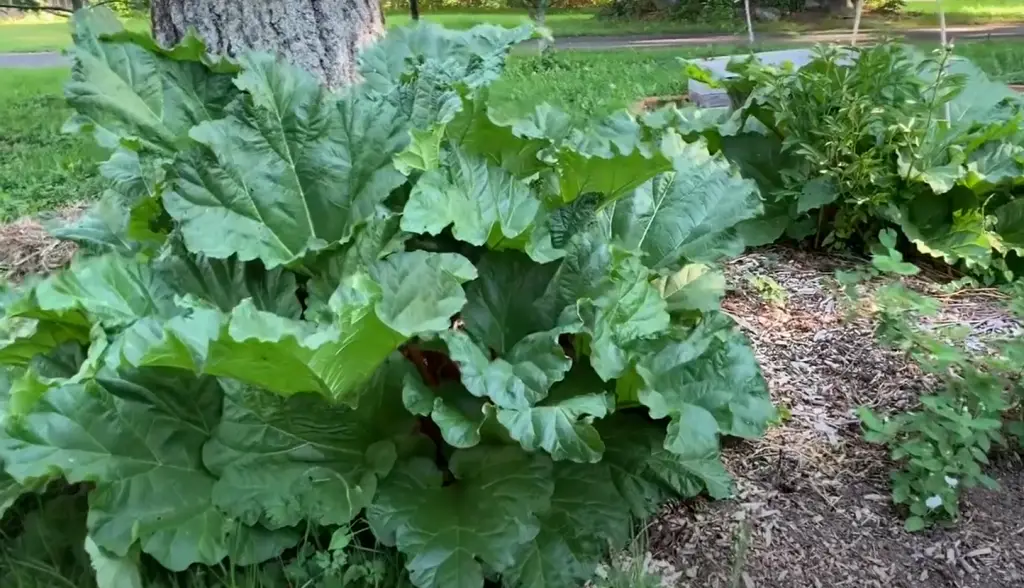
This plant loves moist soil, so make sure you water it regularly to keep it healthy and happy!
Brazilian Giant Rhubarb
This large-leafed plant is a native of South America and grows in clumps, with new shoots emerging from the center. Its leaves are slightly longer than those of ordinary rhubarb, but they still retain that distinct sour flavor. Brazilian Giant Rhubarb also has an interesting red hue when mature, making it a great addition to any garden.[3]
Canare Dock
Canare Dock is a beautiful and unique perennial that looks like rhubarb. It has long, narrow, veined leaves and bright red stems. The plant grows in an upright habit and can reach up to 4 feet tall when mature. Canare Dock is also drought-tolerant and thrives in full sun or partial shade, making it an ideal choice for a garden border or in containers.[2]
Mountain Rhubarb
Another plant that looks like rhubarb is Mountain Rhubarb. This low-growing perennial has thick, fan-shaped leaves and bright green stems. It flourishes in high altitude areas and requires full sun to partial shade. Mountain Rhubarb can reach up to 3 feet in height and produces yellow flowers in the spring.
Swiss Chard
Swiss Chard is a vegetable that has leaves and stems similar to rhubarb. It’s an excellent source of dietary fiber, which can help keep your digestive system healthy. Swiss chard also contains vitamins A, C, and K, as well as iron and calcium. Plus, its bright green color makes it stand out in any garden![2]
Beetroot
Beetroot is a great choice if you want to add some of the same characteristics as rhubarb. It has a similar texture, and while its flavor isn’t quite like rhubarb, it still adds an interesting element to your garden. Plus, beetroots are easy to grow and can be harvested in just a few weeks.
Celery
Celery has a similar texture and taste to rhubarb, so it’s a great choice if you’re looking for something that mimics the flavor. Celery is also easy to grow in most climates, and it doesn’t require much maintenance.
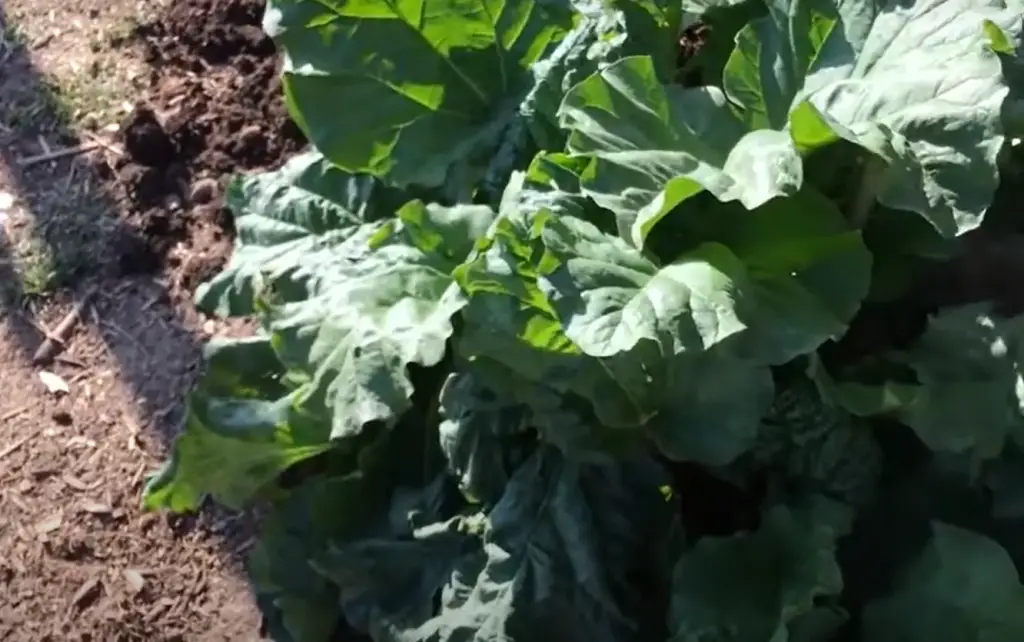
You can harvest celery within two months of planting.[2]
Greater Burdock
Greater Burdock (Arctium lappa) is a hardy, perennial plant that grows to four feet tall and has thick, fleshy roots. The leaves are large and heavily veined with small purple flowers that are followed by burrs. It’s an edible plant but also makes a great ornamental addition to the garden.
Monk’s Rhubarb
This unique plant is a perennial that looks like Rhubarb and can get up to 8 feet tall. It has thick, red-purple foliage with white flowers in the spring, making it an eye-catching addition to any garden. Monk’s Rhubarb is a hardy plant and can tolerate drought and frost.
Indian Rhubarb
The Indian Rhubarb, also known as Darmera peltata, is a deciduous perennial with glossy green leaves and a thick red stem. The leaves of the plant are heart shaped and have deep veins throughout. This species can reach 9 feet in height and is most often found growing near rivers or fresh water sources. In early spring it produces small yellow flowers that are quite beautiful.
Ostrich Ferns
The Ostrich Fern is another plant that looks a lot like rhubarb.
The leaves have an ostrich-feather pattern and the stem has a deep burgundy color. It’s great for providing ground cover and attracts pollinators like bees, butterflies and moths.Burdock Weed
Burdock Weed is a common weed found in gardens throughout Britain. It has large, oval-shaped leaves with jagged edges and a thick stem that can reach up to three feet tall. While it’s not as tart as rhubarb, the leaves of Burdock Weed are edible and can be added to salads or cooked for a unique flavor.
Sorrel
Sorrel is a perennial herb that’s known for its tart, lemony flavor. It’s often used in soups and stews, but can also be eaten raw or brewed into tea. Sorrel looks similar to rhubarb with its oval-shaped leaves and solid stems, but it has a distinctively sour flavor.[2]
Japanese Knotweed
Japanese Knotweed is a popular ornamental plant in many gardens. It has deep green leaves and thick stems that can reach up to six feet tall. This plant is known for its tart, lemony taste and can be eaten raw or added to salads or cooked dishes.
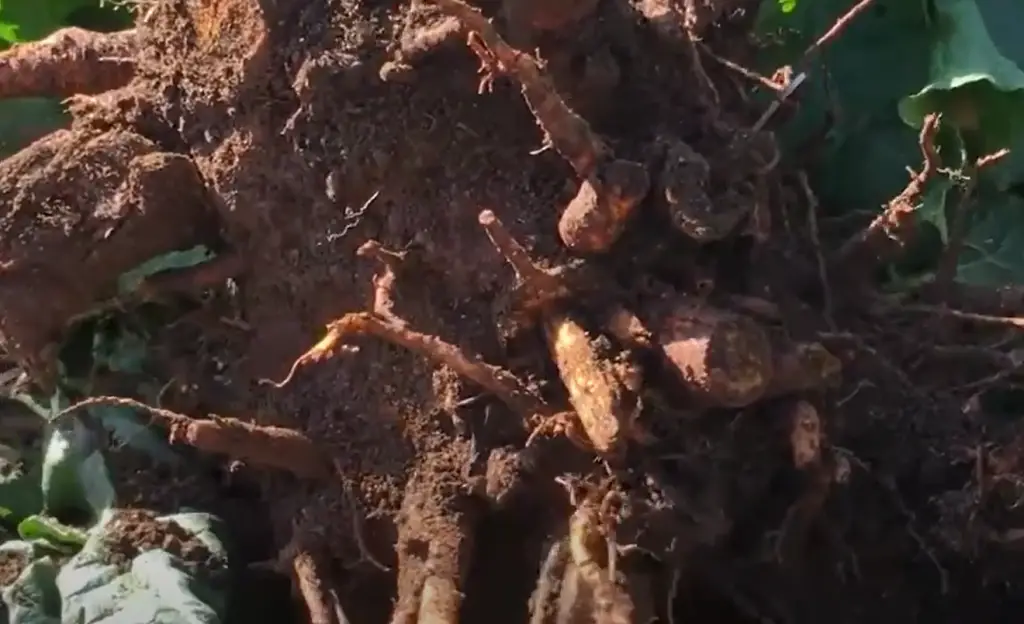
All of these plants look similar to rhubarb, but they have their own unique flavors and textures.
With some careful planning and attention to detail, you can create a space that is both visually appealing and flavorful. And who knows – maybe your garden will even become the envy of the neighborhood![2]Arctium Minus
Arctium Minus is an herb in the daisy family and commonly known as Lesser Burdock. This plant has large, velvety leaves that resemble rhubarb. It can reach up to four feet tall and produces small purple flowers during the summer months.
FAQ
Is there such a thing as false rhubarb?
No, false rhubarb is not a real plant. However, there are some garden plants that look like rhubarb and have similar characteristics to the vegetable. These include Brazilian Giant Rhubarb, Canare Dock, Mountain Rhubarb, Swiss Chard, Beetroot, Celery, Greater Burdock, Monk’s Rhubarb, Indian Rhubarb, Ostrich Ferns, Burdock Weed, Sorrel and Japanese Knotweed.
How can you tell the difference between burdock and rhubarb?
Burdock looks similar to rhubarb in that it has large, oval-shaped leaves and a thick stem. However, the leaves of burdock are more jagged than those of rhubarb and it produces small burrs rather than flowers. The flavor of burdock is also more acidic than rhubarb, which is why it’s often used in salads.
What is the Japanese plant that looks like rhubarb?
The Japanese plant that looks like rhubarb is called Japanese Knotweed (Fallopia japonica). This plant has deep green leaves and thick stems that can reach up to six feet tall. It has a tart, lemony flavor and can be eaten raw or added to salads or cooked dishes.
What can be mistaken for rhubarb?
There are a few plants that can be mistaken for rhubarb. These include Swiss Chard, Beetroot, Celery, Greater Burdock, Monk’s Rhubarb, Indian Rhubarb, Ostrich Ferns, Burdock Weed and Sorrel. All of these plants look similar to rhubarb but have their own unique flavors and textures.
What is similar to rhubarb?
Beetroot is a great choice if you want to add some of the same characteristics as rhubarb. It has a similar texture, and while its flavor isn’t quite like rhubarb, it still adds an interesting element to your garden. Celery also has a similar texture and taste to rhubarb, so it’s a great choice if you’re looking for something that mimics the flavor.
What is the vegetable that looks like rhubarb?
The vegetable that looks most like rhubarb is Swiss Ch (Beta vulgaris). It has large, green leaves and a thick stem that can reach up to 3 feet in height. It’s known for its tart, lemony flavor and can be eaten raw or added to salads or cooked dishes. However, it should be noted that Swiss Chard does not have the same sour flavor as rhubarb.
What is the big plant that looks like rhubarb?
The big plant that looks like rhubarb is Indian Rhubarb (Darmera peltata). This deciduous perennial can reach up to 9 feet in height and has glossy green leaves with a thick red stem. It produces small yellow flowers in early spring, making it an eye-catching addition to any garden.
What wild plant looks like rhubarb UK?
The wild plant that looks most like rhubarb in the UK is Burdock Weed (Arctium minus). This weed has large, oval-shaped leaves with jagged edges and a thick stem that can reach up to three feet tall. It’s not as tart as rhubarb, but its leaves are edible and can be added to salads or cooked for a unique flavor.
Useful Video: Rhubarb: From Planting To Harvest ❤️ 💚
Conclusion
Garden plants that look like rhubarb can be a great addition to any garden. From Ostrich Ferns and Burdock Weed to Japanese Knotweed and Sorrel, there are plenty of options available to choose from. No matter what you’re looking for, these plants can bring a unique flavor to your garden. Plus, with careful planning and attention to detail, you can create a visually appealing and flavorful space that will be the envy of the neighborhood.
Happy gardening!
References:
- https://www.evergreenseeds.com/plants-that-look-like-rhubarb/
- https://farmfoodfamily.com/plants-that-look-like-rhubarb/
- https://www.progardentips.com/plants-that-look-like-rhubarb/





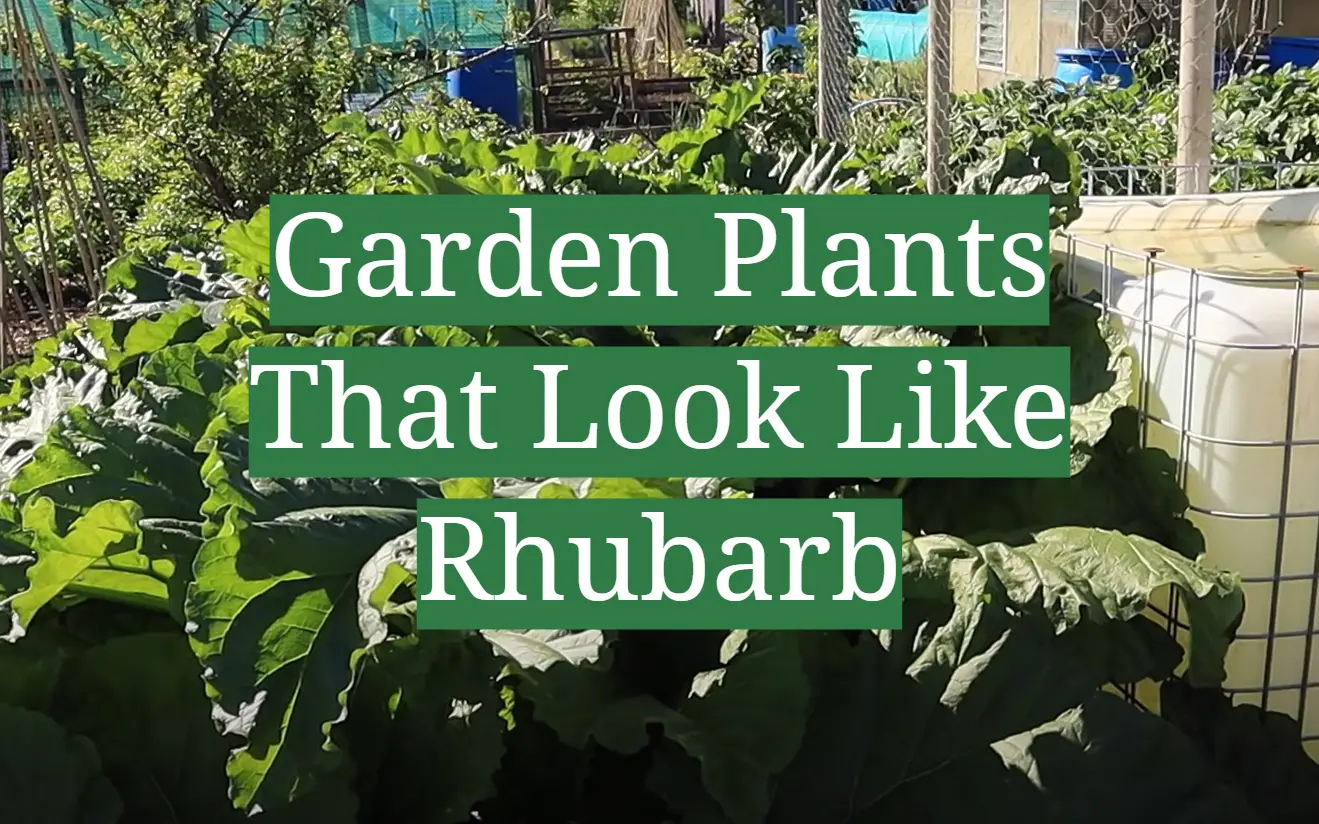




Leave a Reply
View Comments